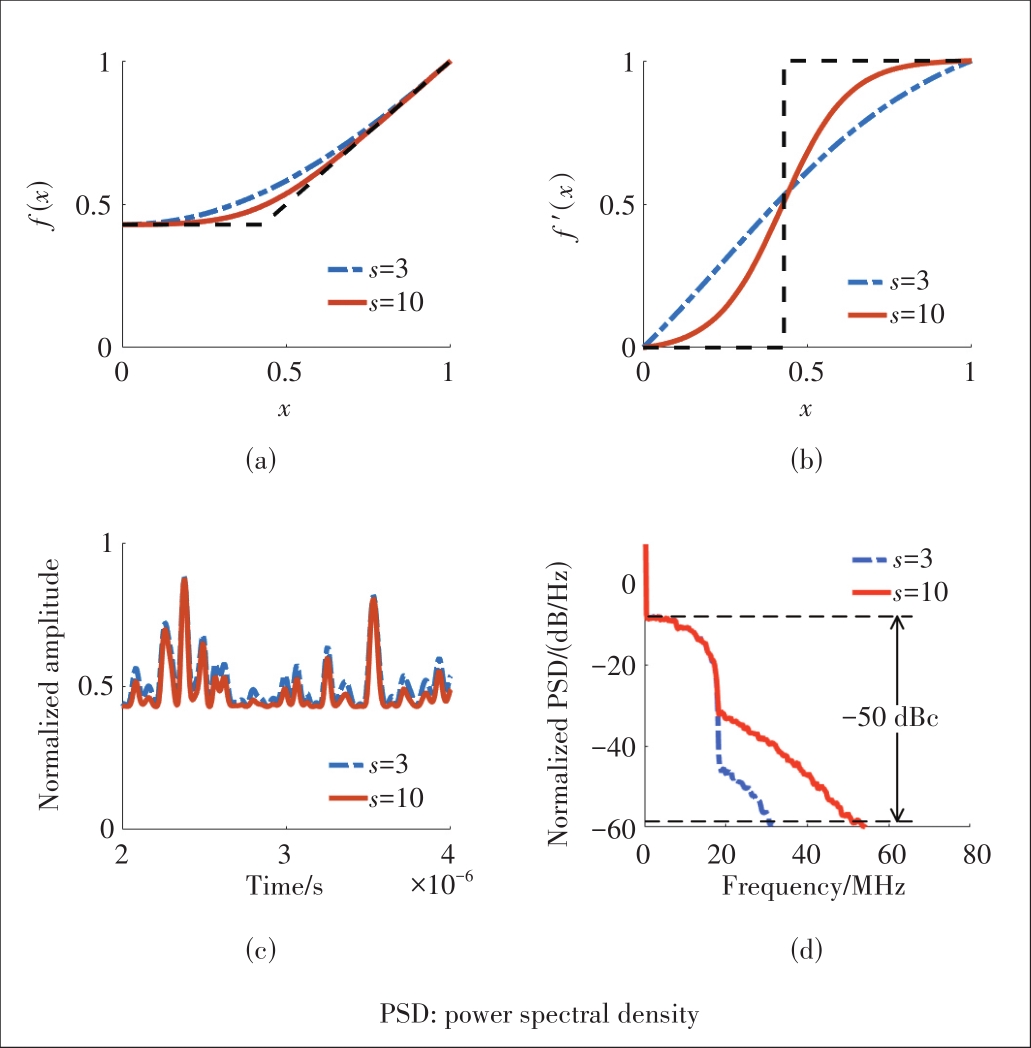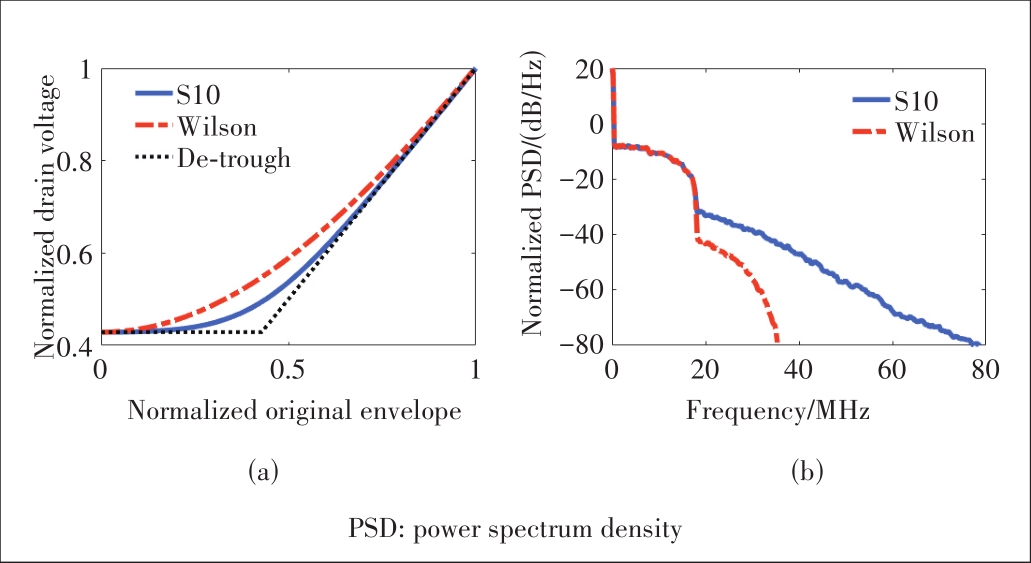ZTE Communications ›› 2022, Vol. 20 ›› Issue (S1): 22-26.DOI: 10.12142/ZTECOM.2022S1004
• Research Paper • Previous Articles Next Articles
YI Xueya1, CHEN Jixin1, CHEN Peng1, NING Dongfang2, YU Chao1( )
)
Online:2022-01-25
Published:2022-03-01
About author:YI Xueya received the B.E. degree in electronic and information engineering from Xidian University, China in 2018. She is currently pursuing the M.E. degree in electromagnetic fields and microwave technology at the State Key Laboratory of Millimeter Waves, Southeast University, China. Her current research interests include bandwidth reduction and shaping of envelope and digital predistortion for wideband envelope tracking power amplifiers.|CHEN Jixin received the B.S. degree in radio engineering from Southeast University, China in 1998, and the M.S. and Ph.D. degrees from Southeast University in 2002 and 2006, respectively, all in electromagnetic field and microwave technique. Since 1998, he has been with the State Key Laboratory of Millimeter Waves, Southeast University. He is currently a professor with the School of Information Science and Engineering and Director of the Department of Electromagnetic Field and Microwave Engineering. His research interests include microwave and millimeter-wave circuit design and monolithic microwave integrated circuit (MMIC) design. Dr. CHEN is the winner of 2016 Keysight Early Career Professor Award and 2016 National Natural Science Prize Second Prize. He has served as TPC Chair of RFIT2019, and TPC Co-Chair of HSIC2012 and UCMMT2012.|CHEN Peng received the B.E. degree in communication engineering and the M.E. degree in electronic engineering from Harbin Institute of Technology, China in 2010 and 2012, respectively, and the Ph.D. degree in electronic engineering from University College Dublin, Ireland in 2016. From 2017 to 2020, he was a research associate with Centre for High Frequency Engineering, Cardiff University, UK. Since 2020, he has been with the State Key Laboratory of Millimeter Waves and is currently a lecturer with the School of Information Science and Engineering, Southeast University, China. His current research interests include the design and optimization of high-efficiency power amplifiers.|NING Dongfang received the M.S. and Ph.D. degrees in control science and engineering from Northwestern Polytechnical University, China in 2016 and 2019. He is currently a senior RF algorithm architect in ZTE Corporation, working in nonlinear system behavioral modeling and linearization for wireless and RF systems.|YU Chao (Supported by:YI Xueya, CHEN Jixin, CHEN Peng, NING Dongfang, YU Chao. Derivative-Based Envelope Design Technique for Wideband Envelope Tracking Power Amplifier with Digital Predistortion[J]. ZTE Communications, 2022, 20(S1): 22-26.
Add to citation manager EndNote|Ris|BibTeX
URL: http://zte.magtechjournal.com/EN/10.12142/ZTECOM.2022S1004

Figure 2 Example of the proposed envelope design: (a) envelope design; (b) derivative of the S function for s=3 and s=10; (c) time domain waveforms; (d) normalized power spectral density of the S envelope
| Parameter | S Envelope | Traditional Envelopes | |||||
|---|---|---|---|---|---|---|---|
| s=3 | s=5 | s=10 | s=16 | Wilson | 2.ord.PET | N6 | |
| BW | 1.6× | 2.1× | 2.6× | 3.0× | 1.6× | 1.6× | 3.0× |
| NMSE/dB | -6.8 | -7.0 | -7.7 | -7.9 | -6.6 | -6.7 | -7.9 |
Table 1 Bandwidth and NMSE of the S envelope and traditional envelopes
| Parameter | S Envelope | Traditional Envelopes | |||||
|---|---|---|---|---|---|---|---|
| s=3 | s=5 | s=10 | s=16 | Wilson | 2.ord.PET | N6 | |
| BW | 1.6× | 2.1× | 2.6× | 3.0× | 1.6× | 1.6× | 3.0× |
| NMSE/dB | -6.8 | -7.0 | -7.7 | -7.9 | -6.6 | -6.7 | -7.9 |

Figure 4 Experiment for validation: (a) plot of samples of the S10 and Wilson envelopes versus the original envelope; (b) normalized power spectrum density of the S10 and Wilson envelopes

Figure 5 Comparison experiment: (a) amplitude-modulation to amplitude-modulation (AM/AM) and amplitude-modulation to phase-modulation (AM/PM) curves; (b) normalized PSD without and with DPD under S10 function; (c) AM/AM and AM/PM curves; (d) normalized PSD without and with DPD under Wilson function
| Shaping Function | Efficiency/% | Without DPD | With DPD | ||
|---|---|---|---|---|---|
ACLRs/dBc ( | NMSE/dB | ACLRs/dBc ( | NMSE/dB | ||
| S10 | 43.8 | -31.3/-31.6 | -21.2 | -51.2/-51.8 | -38.5 |
| Wilson | 42 | -33.3/-33.5 | -23.6 | -54.0/-54.3 | -40.5 |
Table 2 Efficiency and nonlinearity performance of the measured ET system
| Shaping Function | Efficiency/% | Without DPD | With DPD | ||
|---|---|---|---|---|---|
ACLRs/dBc ( | NMSE/dB | ACLRs/dBc ( | NMSE/dB | ||
| S10 | 43.8 | -31.3/-31.6 | -21.2 | -51.2/-51.8 | -38.5 |
| Wilson | 42 | -33.3/-33.5 | -23.6 | -54.0/-54.3 | -40.5 |
| 1 |
GILABERT P L, MONTOTORO G, VEGAS D, et al. Digital predistorters go multidimensional: DPD for concurrent multiband envelope tracking and outphasing power amplifiers [J]. IEEE microwave magazine, 2019, 20(5): 50–61. DOI: 10.1109/mmm.2019.2898021
DOI URL |
| 2 |
MA J G. RF Front-End Designs of MIMO Systems for 5G and Beyond [J]. ZTE technology journal, 2020, 26(4): 50-576. DOI:10.12142/ZTETJ.202004012
DOI |
| 3 |
ASBECK P, POPOVIC Z. ET comes of age: envelope tracking for higher-efficiency power amplifiers [J]. IEEE microwave magazine, 2016, 17(3): 16–25. DOI: 10.1109/mmm.2015.2505699
DOI URL |
| 4 | WU R L, LI Y, LIE Y C. Design technologies for silicon-based high-efficiency RF power amplifiers: a brief overview [J]. ZTE communications, 2011, 9(3): 28–35 |
| 5 |
KWAN A, YOUNES M, DARRAGI R, et al. On track for efficiency: concurrent multiband envelope-tracking power amplifiers [J]. IEEE microwave magazine, 2016, 17(5): 46–59. DOI: 10.1109/mmm.2016.2525118
DOI URL |
| 6 |
MONTOTORO G, GILABERT P L, BERTRAN E, et al. A method for real-time generation of slew-rate limited envelopes in envelope tracking transmitters [C]//IEEE International Microwave Workshop Series on RF Front-ends for Software Defined and Cognitive Radio Solutions (IMWS). IEEE, 2010. DOI: 10.1109/IMWS.2010.5441005
DOI URL |
| 7 |
JEONG J, KIMBALL D F, KWAK M, et al. Wideband envelope tracking power amplifiers with reduced bandwidth power supply waveforms and adaptive Digital predistortion techniques [J]. IEEE transactions on microwave theory and techniques, 2009, 57(12): 3307–3314. DOI: 10.1109/tmtt.2009.2033298
DOI URL |
| 8 |
YI X Y, CHEN J X, LI H T, et al. Integrated bandwidth reduction and shaping technique for wideband millimeter wave envelope tracking power amplifier with digital predistortion [C]//International Wireless Symposium (IWS). IEEE, 2020. DOI: 10.1109/IWS49314.2020.9360052
DOI URL |
| 9 |
KWAN A K, YOUNES M, HAMMI O, et al. Linearization of a highly nonlinear envelope tracking power amplifier targeting maximum efficiency [J]. IEEE microwave and wireless components letters, 2017, 27(1): 82–84. DOI: 10.1109/lmwc.2016.2629983
DOI URL |
| 10 |
HAMMI O, KHALIFA M O, ABDELHAFIZ A, et al. A dual-input two-box model for digital predistortion of envelope tracking power amplifiers [J]. IEEE microwave and wireless components letters, 2016, 23(5): 361–363. DOI: 10.1109/Lmwc.2016.2548984
DOI URL |
| 11 |
GILOVANNELLI N, VLASITS T,CIDRONALI A, et al. Efficiency and linearity enhancements with envelope shaping control in wideband envelope tracking GaAs PA [C]//International Workshop on Integrated Nonlinear Microwave and Millimetre-Wave Circuits (INMMiC). IEEE, 2011. DOI: 10.1109/INMMIC.2011.5773331
DOI URL |
| 12 | WANG Z C. Envelope tracking power amplifiers for wireless communications [M]. London, England: Artech House, 2014: 216–224 |
| 13 |
OLAVSBRATEN M, GECAN D. Bandwidth reduction for supply modulated RF PAs using power envelope tracking [J]. IEEE microwave and wireless components letters, 2017, 27(4): 374–376. DOI: 10.1109/lmwc.2017.2679046
DOI URL |
| 14 |
MORGAN D R, MA Z X, KIM J, et al. A generalized memory polynomial model for digital predistortion of RF power amplifiers [J]. IEEE transactions on signal processing, 2006, 54(10): 3582–3860. DOI: 10.1109/tsp.2006.879264
DOI URL |
| [1] | Ruili Wu, Jerry Lopez, Yan Li and Donald Y.C. Lie. Design Technologies for Silicon-Based High-Efficiency RF Power Amplifiers: A Brief Overview [J]. ZTE Communications, 2011, 9(3): 28-35. |
| Viewed | ||||||
|
Full text |
|
|||||
|
Abstract |
|
|||||